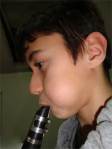|
Taken from my book You have already learned how to hold the clarinet properly. We need a permanent control and introspection whether we have fully adopted it. The basis of good playing and a favorable impression on viewers and listeners are correct, ie. natural and relaxed position in holding the instrument without squeezing and spasm. In order to have your fingers relaxed, not stiff and thus impeded in its function, it is necessary to: 1) keep them bent in a gentle curve; |

Monthly Archives: January 2012
POSITION OF THE MOUTHPIECE IN YOUR MOUTH
|
Place the upper teeth on the upper surface of the mouthpiece closer to the top. Fold the upper lip and cleave it with the upper teeth and upper part of the mouthpiece. Lean the lower lip slightly on the lower teeth. It supports one-third (up to half) of the lower part of the mouthpiece, ie. the reed (see picture left). To relieve the pressure of the lower teeth to the lower lip keep the chin tight. It is very important from the very start. Never play with “Popeye” chin and inflated cheeks (see photo right). Taken from my book |
MAKING SOUND
|
Suppressed air from the lower parts of the lungs moves on freely to the mouthpiece just like a river flow. Its only “barrier” is the tongue which, with its top side, (a bit over the top) lies soft on a mouthpiece. We make the initial tone (attack) with a small separation of the tongue (“barrier”) from the mouthpiece, in order to get (pour) the air flow through it. At the same time, we pronounce the syllable ta softly (we simply insert it into the mouthpiece) and it may also be pronounced tu, to, ti, te – depending on the country and its schools. Reedy tab vibrates and creates a tone. The tone must be clear, bright and pleasing to the ear. When moving the tongue, the chin should remain stable. It should not make chewing gestures. This also applies to the lower lip. Mouthpiece should also rest on the lower lip and should not move when the tongue moves. Taken from my book |
BREATHING TECHNIQUE
|
The technique of breathing is the basis of playing the clarinet and each clarinetist has to practice it. It is firstly done without an instrument. Very important thing is to learn how to save air consumption and a long breath.
1. INHALING. The air is inhaled through the mouth (not through the nose!). While the mouthpiece is in the mouth, quickly, quietly and easily inhale a larger amount of air with the corners of the lips (Do not raise chest and shoulders!). When doing this, we should feel that the inhaled air automatically “drops” into the lower parts of the lungs. Diaphragm (a muscle that divides the chest cavity from the abdomen) curves down and leans on the abdominal cavity. The stomach is arched forward, and the lower ribs are spread in all directions (see picture left). Then we get a sense of simultaneous filling of the stomach downward, forward, backward and from the sides. 2. HOLDING. Hold the inhaled air for a short time. At this stage of breath-holding, a clarinetist is like a rifle at the ready. In this way a firm supporter to a qualitative air column is created. 3. EXHALATION follows after a short breath – holding. Shrinking the abdominal muscles and returning the ribs to their natural position, the diaphragm arches upwards into the thoracic cavity (see picture right) and the air is being forced out. During exhalation we should have a sense of gradual forcing out the air ”from the stomach” on all sides evenly to the clarinet mouthpiece (as through a narrow tube). Taken from my book |
SUSTAINING LONG NOTES
|
Sustaining the long notes in one breath enables conscious control of spending and saving air, ie. breath, as well as the balanced quality of tone. Also, by sustaining the long tones lip muscles strengthen and we gain control over them. In doing so it is reflexively understood to which extent their activities affect the quality of their tone and sustain longer playing. The positioning of the lips to the mouthpiece and the activity of all lip muscles is called embouchure. After a period of active practice mentioned muscles become more durable, and it is usually said that a perfomer is in good condition and has a fine embouchure. Taken from my book |







